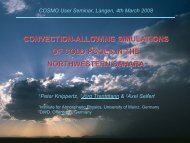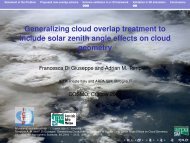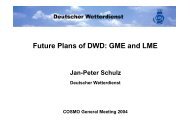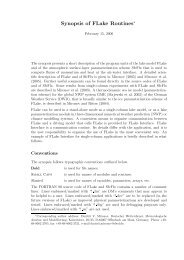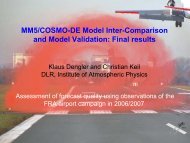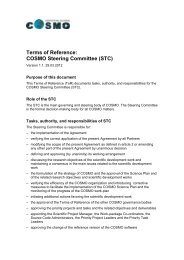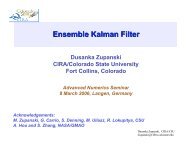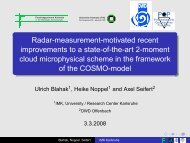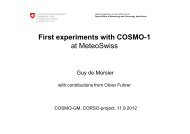MRU Cardington Instrumentation Facility - Cosmo
MRU Cardington Instrumentation Facility - Cosmo
MRU Cardington Instrumentation Facility - Cosmo
Create successful ePaper yourself
Turn your PDF publications into a flip-book with our unique Google optimized e-Paper software.
5 Radiation measurement 115.1 Kipp & Zonen CM21/CM22 Pyranometer . . . . . . . . . . . . . . . . . . . 125.1.1 Purpose of Instrument . . . . . . . . . . . . . . . . . . . . . . . . . . 125.1.2 Principles of Operation . . . . . . . . . . . . . . . . . . . . . . . . . . 135.1.3 Instrument setup . . . . . . . . . . . . . . . . . . . . . . . . . . . . . 155.1.4 Calibration . . . . . . . . . . . . . . . . . . . . . . . . . . . . . . . . 155.1.5 Maintenance . . . . . . . . . . . . . . . . . . . . . . . . . . . . . . . . 155.2 Kipp & Zonen CG4 Pyrgeometer . . . . . . . . . . . . . . . . . . . . . . . . 165.2.1 Purpose of Instrument . . . . . . . . . . . . . . . . . . . . . . . . . . 165.2.2 Principles of Operation . . . . . . . . . . . . . . . . . . . . . . . . . . 165.2.3 Instrument setup . . . . . . . . . . . . . . . . . . . . . . . . . . . . . 185.2.4 Calibration . . . . . . . . . . . . . . . . . . . . . . . . . . . . . . . . 185.2.5 Maintenance . . . . . . . . . . . . . . . . . . . . . . . . . . . . . . . . 185.3 Heitronics KT15D Infrared Thermometer . . . . . . . . . . . . . . . . . . . . 195.3.1 Purpose of Instrument . . . . . . . . . . . . . . . . . . . . . . . . . . 195.3.2 Principles of Operation . . . . . . . . . . . . . . . . . . . . . . . . . . 195.3.3 Instrument setup . . . . . . . . . . . . . . . . . . . . . . . . . . . . . 206 Visibility and aerosol measurements 206.1 Belfort MRI Integrating Nephelometer (Model1550B) . . . . . . . . . . . . . 206.1.1 Background . . . . . . . . . . . . . . . . . . . . . . . . . . . . . . . . 20ii
6.1.2 Principles of Operation . . . . . . . . . . . . . . . . . . . . . . . . . . 226.1.3 Maintenance . . . . . . . . . . . . . . . . . . . . . . . . . . . . . . . . 236.1.4 Calibration . . . . . . . . . . . . . . . . . . . . . . . . . . . . . . . . 237 Sub-soil sensors 237.1 Delta-T ThetaProbe Soil Moisture Sensor . . . . . . . . . . . . . . . . . . . 247.1.1 Purpose of Instrument . . . . . . . . . . . . . . . . . . . . . . . . . . 247.1.2 Principles of Operation . . . . . . . . . . . . . . . . . . . . . . . . . . 247.1.3 Sensor installation . . . . . . . . . . . . . . . . . . . . . . . . . . . . 258 Miscellaneous sensors 258.1 Tipping bucket rain gauge (Mk 5) . . . . . . . . . . . . . . . . . . . . . . . . 268.1.1 Purpose of Instrument . . . . . . . . . . . . . . . . . . . . . . . . . . 268.1.2 Principles of Operation . . . . . . . . . . . . . . . . . . . . . . . . . . 268.1.3 Calibration . . . . . . . . . . . . . . . . . . . . . . . . . . . . . . . . 278.1.4 Maintentance . . . . . . . . . . . . . . . . . . . . . . . . . . . . . . . 279 Data Logging 2710 Data Processing and Format 2910.1 Data Filenames . . . . . . . . . . . . . . . . . . . . . . . . . . . . . . . . . . 2910.2 Data File Format . . . . . . . . . . . . . . . . . . . . . . . . . . . . . . . . . 2910.3 Data Parameter List . . . . . . . . . . . . . . . . . . . . . . . . . . . . . . . 311
1 IntroductionThe Met. Research Unit, located at <strong>Cardington</strong> in Bedfordshire (52 ◦ 06 ′ N, 00 ◦ 25 ′ W, 29 m amsl),maintains a suite of surface-based and mast-mounted instrumentation. The main purposeof this instrumentation site, which is logged 24 hours a day, is to provide data for atmosphericprocesses research, and for the testing and validation of numerical model output andperformance.The <strong>Cardington</strong> site has an open fetch in all directions, with the exception of to the north,where the presence of two large airship hangars have a major influence on the air flow.Measurements of turbulence therefore, when the wind is coming from a direction of roughly355 ◦ to 035 ◦ , should be treated with caution.Figure 1: <strong>Cardington</strong> airship hangars (with instrumented 10 m mast in foreground).N.B. The inclusion in this document of the name of a company does not constitute anyendorsement or recommendation by the Met Office of that company’s products or services.2
2 Wind and turbulence measurementThree Gill Solent HS-50 Horizontally Symmetrical Research ultrasonic anemometers, areused for making fast response wind measurements, which can be used in eddy correlationcalculations. A fast response temperature measurement is also generated. Measurementsare made at heights of 10 m, 25 m and 50 m.Figure 2: Ultrasonic anemometer mounted at the top of the 25 m mast.temperature and humidity sensors inside aspirated screens.(Also present:2.1 Gill Solent Ultrasonic Anemometer2.1.1 Purpose of InstrumentThe ultrasonic anemometer is used for making rapid response measurements of the 3-dimensionalwind field. A fast response temperature measurement is also generated. Data obtained fromthe instruments allows a range of turbulence parameters and fluxes to be derived, using eddycorrelation methods, in addition to obtaining the mean horizontal wind.Currently, three HS-50 model sonic anemometers are deployed on the site, (located at the3
tops of masts of heights 10 m, 25 m and 50 m), but a number of HS model anemometers arealso available for use. These two instruments are essentially the same, except that the HS-50measures at a raw sampling rate of 50 Hz as opposed to 100 Hz.The anemometers are logged at a rate of 10 Hz (block averages over the raw sampling rate).This rate is sufficient to resolve the small scale eddies in the atmosphere at the three measurementheights.2.1.2 Principles of OperationThe sensor head of the anemometer consists of an array of three pairs of transducers orientatedat different angles across the measurement region. Each pair of transducers actalternately as transmitters and receivers, sending pulses of ultrasound between them. Bymeasuring the time of flight of the pulse in both directions, the velocity component of theair flow along the line of the transducer pair can be determined using equation 1.( 1v = 0.5L × − 1 )t 1 t 2(1)where t 1 and t 2 are the measured times for the pulses to travel in each direction, and L isthe distance between the transducers.This measurement is carried out for each of the three transducer pairs in turn. A mathematicaltransformation is then performed, to convert the resulting three wind vectors intoU, V, W format, where U and V are the horizontal wind components parallel and perpendicularto the instrument axis, and W is the vertical wind component. A correction is thenapplied, to calibrate out the affects of the transducers and instrument frame on the airflow.In addition to computing the wind vectors, the sonic anemometer also uses the time-offlightmeasurement to calculate the speed of sound (c) along each axis. From this, thesonic temperature (equivalent to the virtual temperature, T v ) of the air is derived, usingequation 2.T v = c2403(2)4
Figure 3: Gill HS ultrasonic anemometerThe speed of sound value used in equation 2 is the mean quantity derived from each ofthe three axes. A correction must then be applied to take into account the effect of thecross-wind normal to the measurement axes. The resulting virtual temperature, can then beconverted into a true temperature, assuming that the pressure and humidity are known.Note that the accuracy of the sonic derived temperature, is not generally good enough tobe relied on as a true temperature measurement. (It can be up to 2–3 ◦ C off.) This islargely due to the fact that it is highly sensitive to very small errors in the speed of soundmeasurement. However, this is not particularly important, because the primary purpose ofthe sonic temperature is as a fast response measurement which can be combined with the Wwind component in order to calculate heat fluxes. A separate PRT sensor is normally usedfor absolute measurements of temperature.The electronics box of the anemometer is equipped with 6 analogue input channels, plus a5
dedicated PRT temperature sensor input. This allows external sensors to be connected tothe sonic and logged at the same time.Each complete measurement cycle is carried out at a rate of 100 Hz (or 50 Hz for the HS50anemometer). The wind and sonic temperature data is then averaged over the desirednumber of cycles, and sent to the serial output of the instrument, along with the digitisedoutput from any external sensors connected to the anemometer. The output from an inbuiltinclinometer is also included in the data stream. This information can be used in subsequentdata processing to correct for errors in alignment of the instrument.Further information on the Gill HS sonic anemometers can be found at the Gill website.2.1.3 Operational NotesThese instruments have an acceptance angle, relative to the instrument axis, of approximately±120 degrees, from where the uninterruped wind flow may be measured. If thewind is outside this sector, then the airflow becomes distorted, resulting in the turbulencemeasurements becoming unreliable. To counter this possibility, the masts are rotated on aregular basis, so that the anemometers remain pointing into the prevailing wind.3 Temperature measurementTemperature measurements are made using PRT (Platinum Resistance Thermometer) probes.These are located at four heights: 1.2 m, 10 m, 25 m and 50 m, and are housed in aspirated,shielded screens. The 1.2 m measurement incorporates an SDL probe and an AutomaticSystems Laboratories model F250 high precision temperature bridge. The remaining threesensors are Vector Instruments model T302 sensors.6
4 Humidity measurementFast response humidity measurements are made using a LI-COR LI-7500 open path CO 2 /H 2 0gas analyser, located at the top of the 10 m tower. In addition to measuring water vapour,this instrument is capable of measuring atmospheric carbon dioxide concentration. Whencombined with simultaneous data from a sonic anemometer, humidity and CO 2 fluxes canbe calculated.Three Vaisala humicaps are employed for measurement of relative humidity. These arelocated at heights of 1.2 m, 25 m and 50 m and are housed in aspirated screens. Estimates ofhumidity flux at 25 and 50 m are also made by correlating the humicap outputs with datafrom the sonic anemometers.A Michell Series 3000 dewpoint hygrometer is situated at a height of 1.2 m above groundlevel. This is mounted inside the 1.2 m temperature screen.Figure 4: The LI-COR LI-7500 gas analyser co-located with a sonic anemometer, on the10 m tower.7
4.1 LI-COR LI-7500 Gas AnalyserFigure 5: LI-COR LI-7500 gas analyser.4.1.1 Purpose of InstrumentThe LI-COR LI-7500 Gas Analyser is used to make rapid response measurements of watervapour and carbon dioxide concentration in the atmosphere. When combined with simultaneousmeasurements from a co-located sonic anemometer, humidity and CO 2 fluxes can becalculated, using the eddy-covariance method.4.1.2 Principles of OperationThe LI-COR LI-7500 Gas Analyser operates by measuring the absorption of infrared radiationat different wavelengths. The picture above shows the sensor head of the instrument.Sapphire windows protect the infrared source and detector. The optical path length is12.5 cm.For each gas, the power recieved from the infrared source is measured at two wavelengths—one at a wavelength that is absorbed by the gas, and the other at a non-absorbing reference8
wavelength. The absorbance a i is then approximated by equation 3.a i = 1 − A iA io(3)where A i is the power received at the absorbing wavelength and A io is the power receivedat the reference wavelength. This measurement is carried out by the LI-7500 at a rate of152 Hz. A value of a is thus obtained for both H 2 0 and CO 2 (after making a correction forthe cross-sensitivity between the two gases), and this is used by the LI-7500 to produce acalibrated output of the number densities (in mmol/m 3 ) of the gases (or, alternatively massdensity, which is obtained by simply multipying the molar concentration by the molecularweight of each of the gases.)There is a small pressure dependency in the conversion of the absorbances of the gases tonumber density (and for CO 2 , also a temperature dependency), which the LI-COR accountsfor using sensors built into the electronics enclosure. The accuracy of these measurementsdoes not have to be very high.In order to convert the output of the LI-7500 into more useful quantities, however, (suchas converting H 2 0 number density into a specific humidity [g/kg], or CO 2 number densityinto molar fraction [ppm]), accurate pressure and temperature measurements of the air arerequired. Post-processing of the LI-COR data uses pressure and temperature sensors locatedon the 10 m mast to perform these calculations.Further information on this instrument can be obtained from the LI-COR website.4.1.3 Operational NotesProblems have been found to occur with this instrument in the presence of precipitation.In fact, all data from the instrument, when there is rain, snow, fog or ice on the windows,should be treated with caution.9
Figure 6: Michell 3000 sensor head.4.2 Michell Series 3000 Dewpoint Hygrometer4.2.1 Purpose of InstrumentThe Michell dewpoint hygrometer uses the chilled-mirror principle, described below, to makea direct measurement of the dewpoint of the air. This is a fundamental humidity parameter,that is independent of other parameters, such as the ambient pressure and temperature.4.2.2 Principles of OperationThe sensor consists of a mirror, fixed onto a Peltier cooling module. A platinum resistancethermometer (PRT) is embedded in the mirror. An LED light source is directed at themirror, and the light is reflected back to a detector. The light detector acts in conjunctionwith the Peltier pump, cooling the mirror until dew or frost begins to form on it. Thispoint is signalled by a drop in the light level received by the detector. In this manner, thetemperature of the mirror is maintained at the temperature of the dewpoint of the ambientair, which is output by the PRT probe.Every 3 hours or so, the sensor undergoes an Automatic Balance Compensation (ABC)cycle. This consists of the system heating the mirror to a high temperature to dry thesurface, and allows the system to automatically compensate for any contaminants that havebuilt up on the mirror. During this ABC cycle, the logging software ignores the data from10
the hygrometer.The airflow rate over the sensor needs to be kept below 1.5 litres/minute to reduce thethermal load on the sensor. The output becomes unstable if this is exceeded. Note that theresponse time of this sensor is of the order of several minutes.4.2.3 Sensor installationThe sensor head is mounted inside the 1.2 m temperature screen (aspirated). In order torestrict the airflow over the sensor, a porous cover (sintered material) is placed over it. Thisalso acts as a filter for particulates.4.2.4 MaintenanceThe build up of dirt on the mirror happens continuously, but in normal operation this iscompensated for by the ABC operation. However if the optics become badly contaminated,then a warning light is illuminated on the control panel, and the optics must be cleanedmanually. If left unattended, this typically occurs after 3–4 weeks of operation. Performanceof the sensor can then become unreliable.To prevent this happening, the policy is to check the unit every week, and clean the opticswhenever the warning light is on, or at least once a month. Cleaning of the optics is carriedout using a cotton bud soaked in isopropyl alcohol, followed by distilled water.5 Radiation measurementThe surface site consists of a full suite of radiometers, measuring all the main componentsof the radiation budget.• Three Kipp & Zonen CM21/CM22 pyranometers, are used to measure global incoming,diffuse, and relected solar irradiances. The diffuse measurement involves shading thesensor from the direct solar beam using a solar tracker.11
• Two Kipp & Zonen CG4 pyrgeometers are used, for measuring the incoming andoutgoing longwave irradiances (with a spectral range of 4.5 to about 40 µm.)• The surface radiative temperature is measured using a Heitronics KT15D Infraredradiation pyrometer pointed at the ground.Figure 7: Radiometers mounted on a Kipp & Zonen solar tracker.5.1 Kipp & Zonen CM21/CM22 Pyranometer5.1.1 Purpose of InstrumentThe pyranometers are used to measure the downward and upward (i.e. reflected) solar irradiancethrough a horizontal surface (in W m −2 ). A Kipp & Zonen CM22 pyranometer isused for the global downwelling component, and a model CM21, from which the direct beamof the sun is obscured, gives the diffuse irradiance. A downward pointing CM21 is used tomeasure the upwelling component over a grass surface.12
Figure 8: Downward-facing pyrgeometer at end of boom, and Heitronics IRT pointing atthe ground.5.1.2 Principles of OperationEach instrument has a thermopile which has one set of black-coated junctions exposed tosolar radiation and the other set buried within the instrument body, which acts as a heatsink.Incoming solar radiation heats the exposed junctions, generating a voltage difference proportionalto the irradiance on that surface. The pyranometers have a nominal sensitivity of5–10 µV / Wm −2 .The spectral range is set by two quartz domes. For the CM21, this is:• 305–2800 nm (50% transmittance points)• 340–2200 nm (95% transmittance points)13
Figure 9: Kipp & Zonen CM21 pyranometer.For the CM22, the range is:• 200–3600 nm (50% transmittance points)• 280–2800 nm (95% transmittance points)The inner dome helps to reduce convective heat losses and shields the thermopile fromlongwave exchange with the outer dome. When the effective sky temperature is very lowa negative zero offset can develop, most noticeably on clear nights. For well ventilatedinstruments, the zero offset should be
5.1.3 Instrument setupTo measure the diffuse irradiance, the CM21 is mounted on a Kipp & Zonen 2AP solartracker.This device follows the sun through the sky, so that a small black sphere is positioned tocontinuously shade the pyranometer thermopile from the direct beam of the sun. The CM22measuring global solar irradiance is mounted next to the CM21 on the solar tracker, but thisis just for convenience and is not shaded.For measuring the reflected solar irradiance, the CM21 is mounted, facing downwards, at theend of a boom, clamped to a mast, at a height of 2 m. The boom extends out approximately1.5 m towards the south, and the mast is painted matt black. This eliminates unwantedinfluences from shadowing and reflections from the mast.All three instruments are ventilated using a fan which blows air over the domes.prevents frost and dew etc. from forming on the domes.This5.1.4 CalibrationThe sensitivity of each instrument is determined initially by the manufacturer by comparisonagainst a standard pyranometer, which has itself been calibrated at the World RadiationCentre in Davos. A spare reference pyranometer is held at <strong>Cardington</strong>, for intercomparisons.5.1.5 MaintenanceThe following tasks are carried out on a weekly basis: checking the operation of the ventilators,checking for dirt on the domes and checking the condition of the dessicant. The domesare cleaned when required. For the diffuse measurement, the alignment of the solar trackermust also be checked.15
Figure 10: Kipp & Zonen CG4 pyrgeometer.5.2 Kipp & Zonen CG4 Pyrgeometer5.2.1 Purpose of InstrumentThe CG4 pyrgeometers are used for the measurement of upwelling and downwelling componentsof LW irradiance (in W m −2 ). The instruments are sensitive to infrared radiation ina wavelength range of 4.5 to approx. 40 µm, and have a field of view of 180 ◦ , with a cosineresponse.5.2.2 Principles of OperationThe CG4 pyrgeometer uses a thermopile to detect thermal gradients caused by incomingradiant energy. The detecting element is a black painted disk, which absorbs the incomingradiation, and the heat flows through to the heatsink, which is the instrument body. Thethermal gradient across the thermopile produces a voltage which is proportional to the netradiation (i.e. the difference between the radiation received at the detector, and the radiationemitted by the pyrgeometer itself). The nominal sensitivity of the thermopile is 10 µV/Wm −2.16
The spectral range of the incoming radiation is restricted by a specially coated silicon window,which filters out unwanted solar radiation below wavelengths of 4.5 µm. The silicon windowis also required to protect the instrument from environmental effects, such as wind and rain.The curve in figure 5.2.2 shows the transmittance characteristics of the silicon window.Figure 11: CG4 Transmittance characteristics graph, source Kipp & Zonen CG4 manual.In order to calculate the incoming LW irradiance at the detector, the temperature of thepyrgeometer body must be known. This is measured using a thermistor (type YSI44031),which is located beside the cold junctions of the thermopile. The downward (or upward)longwave radiation is then calculated using equation 4.LW = U emfS+ ( 5.67 × 10 −8 × T 4 bwhere U emf is the output voltage from the thermopile, S is the calibration constant of theinstrument, and T b is the pyrgeometer body temperature, measured by the thermistor, indegrees Kelvin.)(4)Note that for an upward facing pyrgeometer, the thermopile output voltage will in mostinstances be negative. This is because the upwelling irradiance from the pyrgeometer islikely to be greater then the incoming irradiance from the sky.Window heating affects (caused by solar radiation creating a thermal gradient between thewindow and the thermopile detector) are very small in the CG4. The manufacturer hasestimated that in full sunlight, the heating offset is less than 4 Wm −2 . However, to minimisethis effect, the direct beam of the sun can be obscured by use of a solar track. (see sectionon instrument setup).17
Further information on the CG4 pyrgeometer can be obtained from the Kipp & Zonenwebsite.5.2.3 Instrument setupThe CG4 pyrgeometer measuring the downwelling LW irradiance, is mounted on a Kipp& Zonen 2AP solar tracker. This tracks the sun through the sky, such that the dome iscontinuously shaded from the direct beam of the sun by a small black sphere. This reasonfor this is to eliminate any window heating affects as described above.For measuring the upwelling LW irradiance from the ground, the CG4 pyrgeometer ismounted, facing downwards, at the end of a boom, clamped onto a mast at a height of2 m. The boom extends out about 1.5 m in a southerly direction. The ground beneath theinstrument, is short grass, and is representative of the whole of thesite.Both the instruments are ventilated by a fan which blows air across the domes. This preventsdew and rain droplets etc. from collecting.5.2.4 CalibrationThe sensitivity of each instrument is determined initially, by the manufacturer by comparisonagainst a standard instrument, traceable back to the World Radiation Centre in Davos. Aspare, reference CG4 is held at <strong>Cardington</strong> for intercomparisons.5.2.5 MaintenanceThe following tasks are carried out on a weekly basis: checking the operation of the ventilators,checking for dirt on the domes and checking the condition of the dessicant. The domesare cleaned when required.18
Figure 12: Heitronics KT15.82D Infrared thermometer5.3 Heitronics KT15D Infrared Thermometer5.3.1 Purpose of InstrumentThe Infrared thermometer is used to measure the radiation temperature of the grass surface.With knowledge of the emissivity, the true temperature can be calculated.5.3.2 Principles of OperationThe instrument measures the thermal radiation emitted by a body. This is dependent on twofactors; the temperature of the body and its emissivity. The instrument has a programmableswitch allowing the emissivity to be adjusted, depending on the nature of the surface beingmeasured. The calculated temperature is then output. For practical purposes, however, theemissivity is always kept at 1. Adjustments can always be made during post-processing toallow for varying emissivities. The instrument outputs both an analogue signal proportionalto the measured temperature, and as serial data.The spectral sensitivity of the KT15.82D infrared thermometer is 8 to 14 µm, and the temperaturemeasurement range is −25–75 ◦ C. The spectral response curve of the instrument isshown in figure 5.3.2.Further information on this instrument can be found on the Heitronics website.19
Figure 13: Spectral response curve of KT15.82D5.3.3 Instrument setupThe IRT is housed in a waterproof shield, and mounted on a mast at a height of 2.5 m abovethe ground. It is tilted at an angle of approximately 20 ◦ to the vertical and the surface belowis short grass, which is representative of the site as a whole.The detector is a ”type A” and an ”M6” lens is used on the unit. This particular setup, thisgives an effective target area on the ground of roughly 1 metre diameter.6 Visibility and aerosol measurementsVisibility is measured using a Belfort model 6230A visibility sensor. An MRI integratingnephelometer (model 1550B) measures the atmospheric scattering coefficient of dry aerosols.6.1 Belfort MRI Integrating Nephelometer (Model1550B)6.1.1 BackgroundThe MRI Integrating nephelometer is used to measure the scattering coefficient of the air,caused by aerosol particulates. This is the oldest piece of equipment currently in use at<strong>Cardington</strong>. Previously, it was installed on the MRF research aircraft, before undergoing arefurbishment and being deployed on the site.20
Figure 14: Nephelometer control unitFigure 15: Nephelometer optical assembly21
Figure 16: Nephelometer air inlet pipe outside hut.6.1.2 Principles of OperationAir is drawn into the the device from outside the hut using a pump, and is then passedthrough a heater before entering the nephelometer. The purpose of the heating is to dry theair so that the nephelometer measures the scattering coefficient of a dry aerosol population.A humidity sensor, located in the inlet pipe between the heater and the nephelometer is usedto monitor the effectiveness of the dehyration, and a PRT sensor measures the temperatureof the air, which is maintained at a maximum of 30 ◦ C.The air being sampled, enters the optical assembly, which is approximately 1.2 m long, andhas a photomultiplier at one end of it. A xenon flashlamp illuminates the chamber, and thephotomultiplier detects the light scattered from the particles in the defined sampling area.Another light detector placed below the flashlamp, is used as a reference. The xenon lampis set to flash at a rate of once every 4 seconds.The measurement of the scattering coefficient of light through the air, is related to the massconcentration of particulates suspended in the air, and to the visibility. Unlike, a standard22
visibility sensor, however this nephelometer only samples the dry aerosol population.6.1.3 MaintenanceRoutine checks are carried out on the instrument to ensure that• the pump is operating correctly,• the xenon lamp is flashing and• the air heater is working properly—this can be done by checking the digital readoutof the humicap and temperature sensor. The relative humidity should be around 30%and the temperature 30 ◦ C.6.1.4 CalibrationCalibration of the nephelometer is achieved by pumping gases of known scattering coefficientsthrough the system. Pure carbon dioxide is used for this, and additionally, a clean aircalibration is carried out by passing filtered air through the system.7 Sub-soil sensorsA number of sub-soil sensors are deployed.These sensors are situated at two differentlocations in the <strong>Cardington</strong> field site (designated the “west” site and the “south” site.):• Volumetric soil moisture content measurements are made using Delta-T ThetaProbes,located at depths of 10 cm, 22 cm, 57 cm and 1.6 m below the surface, at both the westand south sites.• Sub-soil platinum resistance thermometer probes measure the soil temperature atdepths of 1 cm, 4 cm, 7 cm, 10 cm, 17 cm, 35 cm, 65 cm and 1 m. (These are located atthe south site only.)23
• Water table depth below the surface is measured at the west and south sites. This isobtained using Druck 1830 series pressure transducers, located inside boreholes in theground.7.1 Delta-T ThetaProbe Soil Moisture SensorFigure 17: Delta-T ThetaProbe7.1.1 Purpose of InstrumentThe Delta-T ThetaProbe is used to measure the volumetric moisture content (q v ) of the soil.This is defined by equation 5q v =(Vw)× 100% (5)V swhere V w is the volume of water and V s is the total volume of the soil sample. A value of0% indicates that the soil is completely dry soil, and 100% is pure water. Typically, for fullysaturated soil, q v will be about 50%.7.1.2 Principles of OperationThe ThetaProbe works on the principle that the volumetric soil moisture content is related tothe apparent dielectric constant (e) of the soil, with there being a linear correlation between24
q v and the square root of e. This relationship has been shown to be valid for many differentsoil types.The probe consists of a waterproof housing, containing the electronics, with four stainlesssteel spikes attached to one end, which are inserted into the soil. A 100 MHz sinusoidal signalis applied to the spikes, and changes in the impedance between them, due to changes in thedielectric constant of the soil, are detected. The probe then outputs an analogue voltagebetween 0 and 1 V DC, which is virtually proportional to the soil moisture content.The precise relationship between soil moisture content and the square-root of e is dependenton the soil type, but after carrying out tests on the soil at <strong>Cardington</strong>, it was decided to usethe manufacterers generalisied calibration coefficients for a mineral soil.Further information on the ThetaProbes can be found on the Delta-T website.7.1.3 Sensor installationThe sensors were installed in the ground, by digging a large hole, and inserting the probesinto the side wall of the hole at the desired depths. In this way, disturbance to the structureof the soil being measured, was kept to a minimum. The hole was then filled in, replacingthe soil in the order that it came out, and the grass resown on top.8 Miscellaneous sensorsA standard Met Office tipping bucket rain-gauge (Mk 5) is used for the recording of rainfall.Barometric pressure is measured to 0.1 hPa using a Setra Model 270 transducer (located ata height of 1.5 m above ground level.)25
Figure 18: Tipping Bucket8.1 Tipping bucket rain gauge (Mk 5)8.1.1 Purpose of InstrumentThe tipping bucket raingauge is used to measure the quantity and rate of rainfall.8.1.2 Principles of OperationThe rain gauge consists of two stainless-steel buckets on a pivot, located beneath the collectingfunnel (750 cm 2 ). The buckets are situated such that only one of them collects rain ata time. When approximately 15 cc of water has been collected (this is equivalent to 0.2 mmof rainfall), the bucket tips and empties, bringing the other bucket under the funnel, andin the process activates a reed switch. Each tip is counted by the data logger, and this isconverted to a an accumulated rainfall amount over the desired measurement period.Note that since the instrument only records rain in discrete quantities of approx 0.2 mm, itis possible that during periods of light rain or drizzle, the instrument will not register anytips. Also, any snow that collects in the funnel will not be measured until it melts.26
8.1.3 CalibrationInitial calibration of the raingauge, is carried out by pouring known volumes of water intothe funnel, in order to ascertain the average quantity required to produce one tip of themechanism. Then, using the equivalence 15 cc = 0.2 mm, a value for mm per tip can becalculated.Further calibration checks can be carried out when the sensor is deployed in the field, bycross checking the ammount measured after a significant rainfall, with the accumulated raincollected in a standard 5in raingauge. Typically, these values are within 5% of each other.If a consistent error is found, then an “ad-hoc calibration” is applied to the tipping bucketcalibration figure.8.1.4 MaintentanceThe chief maintenance task is to ensure that the collecting funnel does not become blockedwith dirt or debris. Weekly inspections are carried out, and the funnel and mechanism arecleaned as required.9 Data LoggingThe overall structure of the logging system is illustrated in figure 9.The three sonic anemometers are logged at a rate of 10 Hz on a PC running windows XP,using software developed in-house. The other sensors that are mounted on the 10, 25 and50 m masts are connected to the analogue inputs of the anemometers and are logged in thesame data streams. Data from the 25 m and 50 m sonics is transmitted to the logging PC,via pairs of radio modems.All the remaining sensors are logged using three commercially available dataTaker DT800loggers. The loggers use a raw sampling rate of 0.5 Hz, and one minute averaged data islogged. Another PC running windows XP interrogates these loggers at regular intervals, anddownloads the data from them.27
Figure 19: Logging schematic diagram.Further information can be found at the dataTaker website.28
10 Data Processing and FormatThe data processing routines output three files per day. These contain data averaged overtime periods of 1 minute, 10 minutes and 30 minutes. Turbulence quantities and data fromslow response sensors are included in the 10 minute and 30 minute datasets only.10.1 Data FilenamesData files are named using the following convention:card YYYYMMDD xx.datwhere YYYY is the year, MM is the month, DD is the day and xx the averaging period ofthe data in minutes (eg. 01, 10 or 30).10.2 Data File FormatThe datasets are ascii files, which begin with a header section. This consists of a list ofthe variables contained within the file. Each line in the variable list is made up of threeelements—a data prefix, a variable label, and a long-hand description of the parameter.The prefix refers to the source of the data within the logging system. For instance, variableswith a 50 m prefix refers to instruments on the 50 m sonic mast, and rad refers to theradiation instrumentation data logger. Some parameters, which are measured at more thanone height, may be allocated the same variable label, but have different data prefixes. A fulllist of parameters available in the files, is given in section 10.3.Data is then aligned in columns, beneath the relevent variable labels and prefixes. Each dataelement is preceded by a symbol, representing the quality control status of the instrument.Possible values for the quality control flags are as follows:| = data OKX = data flagged as bad29
m = data missing? = possibly suspect datac = calibration suspectD = sonic orientation bad for wind directionH = wind coming from hangar directionA dummy value (1x10 11 ) is substituted for any data which has been assigned an ‘X’ flag.‘D’ and ‘H’ flags are applied to data derived from the sonic anemometers only, and indicatethat the wind, and turbulence data in particular, may not be reliable.To read in data from a single file, the PVWAVE/IDL function read proc file.pro, may beused. This program returns an unnmamed structure consisting of a 2-D data array, andarrays containing the labels, prefixes and QC flags.30
10.3 Data Parameter ListThe table below shows a list of the parameters currently contained within the datasets.Some of the parameter labels are common to more than one data prefix and so referencemust be made to both the variable label and the prefix when extracting the desired datafrom the file. For example, to access the mean windspeed at 25 m, the variable labelled‘UTOT’, and having a prefix ‘25 m’ should be accessed. Other variables on the other hand,are unique to a single data prefix, and so reference need only be made to the variable label(eg. ‘VISI’ for the visibility).Parameter Label Prefix NotesTime [hrs] HOUR time Midpoint of averaging periodTemperature [ ◦ C] TEMP screen, 10 m,25 m, 50 m “screen” temperature and humidityRelative humidityRHHUscreensensors located at 1.2 m above groundfrom Humicap [%]levelDewpoint fromDEWPscreenMichell hygrometer[ ◦ C]Specific humidityQMICscreenfrom Michellhygrometer [%]Relative humidityRHMIscreenfrom Michellhygrometer [%]Relative humidityMRH25 m, 50 mfrom Humicap [%]Specific humidity[g kg −1 ]QLIC10 mfrom LI-CORC0 2 concentrationMCO210 m[ppm]31
Parameter Label Prefix NotesMean wind speed[m/s]UTOT 10 m, 25 m,50 mWind direction [deg] DIR 10 m, 25 m,50 mMaximum gust (1) UMAX 10 m, 25 m,[m/s]50 mVariance U wind UU 10 m, 25 m,component (1) [m 2 /s 2 ]50 mVariance V wind VV 10 m, 25 m,component (1) [m 2 s −2 ]50 mVariance W wind WW 10 m, 25 m,component (1) [m 2 s −2 ]50 mVariance SonicTT 10 m, 25 m,Temperature (1) [K 2 ]50 mCovariance U and UW 10 m, 25 m,W (1) [m 2 s −2 ]50 mCovariance V and VW 10 m, 25 m,W (1) [m 2 s −2 ]50 mCovariance U and UV 10 m, 25 m,V (1) [m 2 s −2 ]50 mCovariance W and WT 10 m, 25 m,T (1) [K m s −1 ]50 mCovariance W and WQL 10 mQ (1) [kg m −2 s −1 ]Covariance W and WQH 25 m, 50 mQ (1) [kg m −2 s −1 ]Covariance W and FCO2 10 mCO (1) 2 [kg m −2 s −1 ]Magnitude and direction of the meanwind vectorPeak scalar windspeed during averagingperiodTurbulence StatisticsThe three wind components aredefined as follows:U is the horizontal wind in thedirection of the mean wind vector.V is the horizontal wind perpendicularto the mean wind vector.(mean V = 0)W is the vertical wind component.(upwards positive)T is the sonic-derived temperatureQ is the specific humidity derived fromeither the LI-COR (10 m) or humicaps(25 m and 50 m)CO 2 concentration is derived from theLI-COR32
Parameter Label Prefix NotesGlobal solarSWDN radirradiance [W m −2 ]Maximum global SWMX radsolar irradiance (1)[W m −2 ]Diffuse solarSWDF radirradiance [W m −2 ]Reflected solar SWUP radirradiance [W m −2 ]Downwelling LW LWDN radirradiance [W m −2 ]Upwelling LW LWUP radirradiance [W m −2 ]Surface radiation IRTG radtemperature [ ◦ C]Visibilty [km] VISI screenNephelometer NEPH radscattering coefficient[km −1 ]Barometric pressure PRES screen 1.2 m above ground level[hPa]Rainfall (1) [mm] RAIN screen Accumulation over averaging periodSoil Moisture (south SMxx subsoil s xx is depth of the sensorsite) (1) [%vol]10 = 10 cm 22 = 22 cmSoil Moisture (west WMxx screen 57 = 57 cm 2M = 1.6 msite) (1) [%vol]Soil Temperature(south site) (1) [ ◦ C]STxx subsoil s xx is depth of the sensor:01, 04, 07, 10, 17, 35 or 65 cmWater table depth WTWE screenDepth below ground level(west site) (1) [mm]Water table depth(south site) (1) [mm]WTSO subsoil s33
(1) Note that the parameters indicated above are not output in the 1 minute datasets. This includesthe various turbulence quantities derived from the sonic anemometers, plus the slow responsemeasurements (i.e. soil moistures and temperatures.)34




